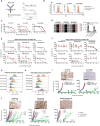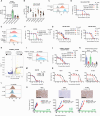This is a preprint.
Identification of DLK1, a Notch ligand, as an immunotherapeutic target and regulator of tumor cell plasticity and chemoresistance in adrenocortical carcinoma
- PMID: 39416174
- PMCID: PMC11482787
- DOI: 10.1101/2024.10.09.617077
Identification of DLK1, a Notch ligand, as an immunotherapeutic target and regulator of tumor cell plasticity and chemoresistance in adrenocortical carcinoma
Update in
-
Identification of the Notch ligand DLK1 as an immunotherapeutic target and regulator of tumor cell plasticity and chemoresistance in adrenocortical carcinoma.Nat Commun. 2025 Jul 1;16(1):5511. doi: 10.1038/s41467-025-60649-w. Nat Commun. 2025. PMID: 40595495 Free PMC article. Clinical Trial.
Abstract
Immunotherapeutic targeting of cell surface proteins is an increasingly effective cancer therapy. However, given the limited number of current targets, the identification of new surface proteins, particularly those with biological importance, is critical. Here, we uncover delta-like non-canonical Notch ligand 1 (DLK1) as a cell surface protein with limited normal tissue expression and high expression in multiple refractory adult metastatic cancers including small cell lung cancer (SCLC) and adrenocortical carcinoma (ACC), a rare cancer with few effective therapies. In ACC, ADCT-701, a DLK1 targeting antibody-drug conjugate (ADC), shows potent in vitro activity among established cell lines and a new cohort of patient-derived organoids as well as robust in vivo anti-tumor responses in cell line-derived and patient-derived xenografts. However, ADCT-701 efficacy is overall limited in ACC due to high expression and activity of the drug efflux protein ABCB1 (MDR1, P-glycoprotein). In contrast, ADCT-701 is extremely potent and induces complete responses in DLK1+ ACC and SCLC in vivo models with low or no ABCB1 expression. Genetic deletion of DLK1 in ACC dramatically downregulates ABCB1 and increases ADC payload and chemotherapy sensitivity through NOTCH1-mediated adrenocortical de-differentiation. Single cell RNA-seq of ACC metastatic tumors reveals significantly decreased adrenocortical differentiation in DLK low or negative cells compared to DLK1 positive cells. This works identifies DLK1 as a novel immunotherapeutic target that regulates tumor cell plasticity and chemoresistance in ACC. Our data support targeting DLK1 with an ADC in ACC and neuroendocrine neoplasms in an active first-in-human phase I clinical trial (NCT06041516).
Conflict of interest statement
Nitin Roper and Jaydira Del Rivero have received research funding from ADC Therapeutics for this study. The other authors have no competing interests to report.
Figures




References
-
- Paz-Ares L. et al. Tarlatamab, a First-in-Class DLL3-Targeted Bispecific T-Cell Engager, in Recurrent Small-Cell Lung Cancer: An Open-Label, Phase I Study. Journal of clinical oncology : official journal of the American Society of Clinical Oncology 41, 2893–2903 (2023). 10.1200/JCO.22.02823 - DOI - PMC - PubMed
Publication types
Associated data
Grants and funding
LinkOut - more resources
Full Text Sources
Medical
